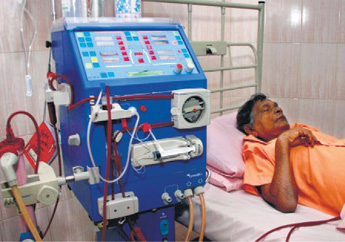Chronic kidney disease of unknown etiology (CKDu) has been sweeping parts of Sri Lanka in recent years, mainly affecting farmers in the North Central Province, but also in the Northern Province, the Eastern Province, the North Western Province, the Uva Province and the Central Province. CKDu cannot be attributed to known factors such as diabetes, hypertension or glomerulonephritis.
Chronic kidney disease (CKD) has killed more people in the North Central Province than the 20-year-long civil war in the area. Over 20 years, up to 20 000 people have died as result of CKD and up to 400 000 more were ill. Some villages report that CKD is responsible for as many as 10 deaths a month.
CKDu deaths in the North Central Province
In the North Central Province and adjacent farming areas, CKDu has escalated to epidemic proportions. The North Central Province comprises the Pollonnaruwa and Anuradapura districts. In the Pollonnaruwa district, about 6580 people were reported to have CDK by the end of November 2017, and, of these, 1458 were CKDu (22%; Table 1).
| Medical Officer of Health area | Chronic kidney disease (no. cases) | Chronic kidney disease of unknown aetiology (no. cases) |
|---|---|---|
|
Medirigiriya |
1913 |
380 |
|
Hingurakgoda |
669 |
158 |
|
Dimbulagala |
1261 |
316 |
|
Lankapura |
444 |
124 |
|
Thamankaduwa |
1059 |
149 |
|
Elahera |
827 |
257 |
|
Walikanda |
407 |
114 |
|
Total |
6580 |
1498 |
Possible causes of CKDu
CKDu is a toxic nephropathy. Research on CKDu has generated various hypotheses, but the most common one is environmental exposure to heavy metal(oid)s. The recent focus on increased productivity to enhance the local and national economy has resulted in significant increases in both fertiliser and pesticide use. Although these additives have led to a significant increase in crop productivity, they have also been linked to an increase in soil contamination and thus contamination of the food supply, causing several human health problems. Hence, our studies aim to quantify people’s exposure to heavy metals.
Heavy metal(oid)s in drinking water
Exposure to heavy metals, such as arsenic (As) and cadmium (Cd), could be from contaminated drinking water. Scientists believe that farmers’ consumption of contaminated water from shallow wells leads to kidney disease in the North Central Province.
Heavy metal(oid)s in irrigated rice
Some researchers believe that exposure comes from rice contaminated with heavy metal(loid)s and other toxins. However, some argue that, although there are high levels of Cd in Sri Lankan rice, zinc (Zn) is also present. Zn inhibits the toxic action of Cd. Some researchers have also found Sri Lankan rice to contain selenium (Se), which also nullifies the action of Cd.
Another argument against rice being the source of the heavy metal contamination is that not all the Cd in rice is bioavailable – only about 50% is. Since some of the remaining bioavailable Cd is nullified by Se and Zn, it is assumed that Sri Lankan rice is, in fact, safe for consumption.
Researchers found that rice cultivated in Sri Lanka is also contaminated with As. They discovered that agrochemical-dependent new improved varieties (NIVs) contain As in the range of 20.6–540.4 µg/kg. However, they have not observed any differences between As content in NIV rice samples from CKDu high- and low-prevalence areas. In addition, traditional varieties also contain toxic metal(loid)s if they are grown with pesticides and fertilisers.
Scientists believe that glyphosate–metal complexes play a role in the current CKDu epidemic in rice paddy farming areas of Sri Lanka. Similar kidney diseases have been reported in Andra Pradesh (India) and Central America. Glyphosate that has formed complexes with minerals or heavy metal(loid)s in drinking water may damage renal tissues, which could lead to fatal kidney disease.
Current research on CKDu
More research needs to be done on the possible cause of CKDu. Currently, Mr Rangana Kulathunga, a PhD student from the Global Centre for Environmental Remediation at the University of Newcastle, Australia, is working to identify possible causes of CKDu neuropathy, mainly in the North Central Province farming community of Sri Lanka. The work is being done under the supervision of Professor Ravi Naidu, Dr Ayanka Wijayawardena and Dr Morrow Dong.
The Medirigiriya Medical Officer of Health area reported the highest number of CKDu patients. Therefore, this area was selected for studying possible factors relating to CKDu in the North Central Province.
The main objectives of this study are to:
- quantify environment exposure to heavy metals through food and drinking water
- map the heavy metal distribution
- investigate the relationship between body mass index and the estimated glomerular filtration rate.
Determining some of the environmental factors affecting CKDu could help farming communities and policy makers to make reliable decisions to overcome this epidemic.


A patient undergoing dialysis in Sri Lanka